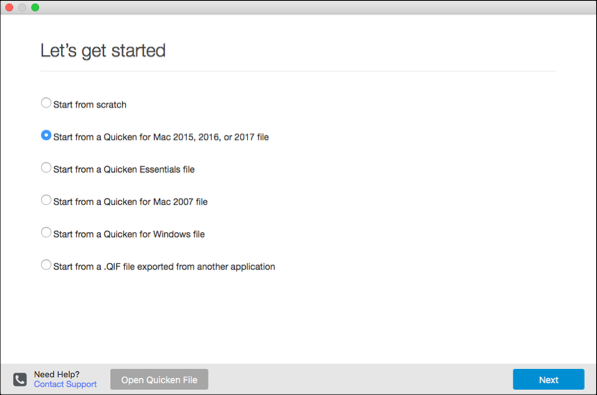Quicken for Windows up to the latest 2020 (and 2019, 2018) version, supports import for QIF and QFX (Web Connect) files. Quicken 2005-2017 imports QIF files.
Here are the major differences between QIF and QFX (Web Connect) format when you try to import them under Quicken:
- Regarding the date: there were two options for exports from Commbiz - QIF or QIF (Quicken AUS, 2004 and earlier). The first starts with!Account and has the date as DD/MM/YYYY and the second starts with!Type:Bank and has the date format as DD/MM/YY but neither work for me when importing. The Online Bank Details tab of the account is fully entered.
- The option to export a qif file is right there in the Q export menu. I first exported my entire data file and imported into MD. Then, as I cleaned up, I found I had to re-import so I picked the specific account I needed and exported the qif file and re-imported into MD. I don’t understand either why it was bandied around there was no qif option.
Vendor Support
QIF format is a great format supporting categories and tags. Quicken was discouraging the QIF format until 2018, but still, all Windows versions import it fine (since Quicken 2018, QIF file is 'officially' supported). Quicken 2005-2017 for Windows has to be at least Deluxe version to import QIF files directly into bank or credit card accounts. Quicken Import Support; If you want to import your Quicken accounts into another application, you can easily do so by exporting them into QIF format. Unfortunately, Quicken 2019 has removed the option to export files in QIF format. It now only exports in QXF which is a proprietary Quicken format that can’t be imported into any program.
Quicken claims that the QIF format is outdated, and not supported anymore, however, still allows importing a QIF file. On the QIF import screen Quicken tells, then you can import a QIF file only under cash account, offering in the drop-down choice for account selection only cash accounts, but also “All Account” as well. Guess what, unless you have Quicken Essentials for Mac, QIF files are fully supported, but not the ones your bank offers you for download. They're slightly different, “Quicken only”, QIF files that Quicken 2012 imports just fine under any account. CSV2QIF - CSV/XLS/XLSX to QIF converter, Bank2QIF - CSV, XLS, XLSX, PDF, QFX, OFX, QBO, QIF, MT940, STA to QIF converter, The Transactions app, which converts from more formats and converts to more formats - will help you create those files.
'Call Home' Required



Quicken does not do any “home calls” during QIF imports, but it does every time you are trying to import a QFX file (yes, you need the Internet connection, your firewall must allow Quicken to go through just to import a QFX file that you have locally on your computer). Quicken checks if the bank code supplied in the QFX file is ‘allowed’ by Quicken for a specific bank and even more bank account type. Some banks come and go, so your bank may drop QFX support tomorrow.
'Online linking'
Once a QFX file is imported under an account in Quicken you choose during the import, it “online links” that account to bank settings supplied in that QFX file. If you have other QFX file with different settings then your currently for the account in “online link”, Quicken will not allow you to import that other QFX file under “occupied” account. The cure for that is simple: edit account, click on the “Online Services” tab and select “deactivate online link”.

Categories and Tag
QFX format as extended OFX format with additional Quicken only details, but the OFX specification does not provide category or tag attribute for transactions (or anything else similar) That’s it; you cannot import categories and tags assigned to your transactions using the QFX (Web Connect) format. On the other hand, QIF format still imports categories and tags just fine. There is a workaround (no great, but some) this limitation for categories: you can set “rename rules” in Quicken to have categories assigned to specific payee names. It should be ok for most payees, but not retailer stores, like Walmart.

Investment transactions
QIF format simplifies investment transactions by limiting security identification to just the security name. That’s it, no ticker symbol, no CUSIP numbers, just full Security name. When you import a QIF file with investment transactions under Quicken (or MS Money), Quicken will look up the security by its full name. You need to make sure your securities names do match the ones on the QIF file, but nothing more. For the QFX (OFX) case, each transaction must be accompanied by the security record with CUSIP supplied. You do need to have a CUSIP number for every security to create a proper QFX file that Quicken can import.
Available converters to convert your existing transaction file to QIF or QFX:
To convert your existing transaction file to QIF format, use the following converters:
Importing .qif File Into Quicken Deluxe 2018 Download
The Transactions app
CSV (or Excel) to QIF: CSV2QIF
PDF to QIF: PDF2QIF
OFX to QIF: Bank2QIF
QFX to QIF: Bank2QIF
QBO to QIF: Bank2QIF
‘Fix’ QIF: FixMyQIF
CSV (or Excel) to QFX: CSV2QFX
PDF to QFX: PDF2QFX
OFX to QFX: OFX2QFX
QBO to QFX: Bank2QFX
QIF to QFX: QIF2QFX